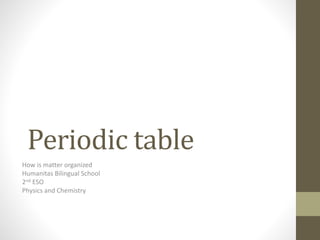
Periodic table
- 1. Periodic table How is matter organized Humanitas Bilingual School 2nd ESO Physics and Chemistry
- 2. Previous ideas • 2500 years ago: four elements(soil, fire, water, air) • DALTON ATOMIC THEORY (1808) • Matter made up of atoms, indivisible and indestructible. • There are different types of atoms with different masses and properties. • Each Chemical element has a different type of atom. • Chemical compounds are made of atoms of different elements. • 118 ELEMENTS: NATURAL ELEMENTS(92) AND ARTIFICIAL ELEMENTS(26) • Chemical symbol: one or two letters. Same in all languages • Fe, N, H, S, Au, Ca, Na, K, C, O, Cl, Ni….. • More than 100 millions Compounds • Chemical Formula.
- 3. PERIODIC TABLE History: first was published by the Russian scientist Dimitri Mendeleiev in 1869 • Double criteria (lately changed) • Mass order (now is atomic number order) • Colums by their chemical properties. ORGANIZATION PERIODS: Horizontal rows (7) GROUPS: Vertical columns(18 ) Elements of the same group have the same number of electrons in the last orbital, so they have similar properties. The elements are in order according to the increasing atomic number (number of protons)
- 4. Link to the periodic table periods groups
- 6. Organization of groups(columns) GROUP 1: ALKALI METALS ALCALINOS GRUPO 2: ALKALI EARTH METALS ALCALINOTÉRREOS GRUPO 3 AL 12: TRANSITION METALS METALES DE TRANSICIÓN GROUP 13: BORON FAMILY GRUPO DEL BORO GROUP 14: CARBON FAMILY GRUPO DEL CARBONO GROUP 15: NITROGEN FAMILY GRUPO DEL NITRÓGENO GROUP 16: OXYGEN FAMILY GRUPO DEL OXÍGENO GRUPO 17: HALOGENS HALÓGENOS GRUPO 18: NOBLE GASES GASES NOBLES. RARE EARTH METALS TIERRAS RARAS
- 8. NAME OF THE ELEMENTS • Greek or Latin (those known from long time ago) • Named after some characteristics. • Named after the home country of the scientist or the name of scientists. • What would be the origin of these elements? Pb Hg Cl Br Po Es Lead Mercury Chlorine Bromine Polonium Einstenium Plomo Mercurio Cloro Bromo Polonio Einstenio
- 9. Other examples of names. • MITHOLOGY: helium, titanium, uranium, neptunium, plutonium. • PLACES: germanium, polonium, francium • PROPERTIES OF THE ELEMENT: beryllium, chlorine, iodine • What is their chemical symbol? And the atomic number?
- 10. Main blocks and characteristics • Metals: • They tend to lose electrons to become stable. • They tend to form positive ions. • They are good thermal and electrical conductors. • 80% of the periodic table. • Non-metals: • They tend o gain electrons to become stable. • They tend to form negative ions. • They are thermal and electrical insulators. • 9% of the known elements are non-metals. • Noble gases • Don’t lose or gain electrons= they are already stable. • Don’t tend to form ions. • They are gaseous, even at very low temperatures. • They don’t combine with other elements or with themselves • 5% of the elements • Semimetals: borderline between metals and non-metals. Semiconductors, similar to both. 6%.
- 13. Valence electrons • Valence shell is the outermost layer with electrons. • Valence electrons is the number of electrons of the valence shell.
- 14. Oxidation number • Basically is the number of electrons that they need to gain or lose to become stable. • They have a negative oxidation number if they need to gain electrons, because electrons have negative charge) • They have a negative oxidation number if they have to lose electrons. • Atoms can have different oxidation numbers depending on the elements they combine with.
- 16. Types of chemical bonds • Atoms of most Elements tend to create bonds with other atoms. • http://concurso.cnice.mec.es/cnice2005/93_iniciacion_interac tiva_materia/curso/materiales/enlaces/enlaces1.htm • Metal + nonmetal = ionic bond • Nonmetal + nonmetal = covalent bond • Metal + metal = metallic bond
- 17. Ionic bond • Ionic bond: Involves a transfer of an electron, so one atom gains an electron while one atom loses an electron. One of the resulting ions carries a negative charge (anion), and the other ion carries a positive charge (cation). Because opposite charges attract, the atoms bond together to form clusters.
- 18. Covalent bond • The most common bond in organic molecules, a covalent bond involves the sharing of electrons between two atoms. The pair of shared electrons forms a new orbit that extends around the nuclei of both atoms, producing a molecule. There are two secondary types of covalent bonds that are relevant to biology — polar bonds and hydrogen bonds. • Molecules video
- 19. Metallic bond • In metallic bonding, which occurs in metals (either a pure metal or an alloy of two or more metals), the valence (outer shell) electrons are donated to a “sea of electrons.” • Metalic clusters